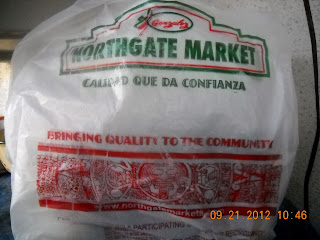As I cannot buy pulque from a pulqueria in Los Angeles and as my only source of Hacienda 1881 pulque had dried up with the closing of the Farm Fresh Market nearest to my home, I emailed the 1881 people and learned that the González Northgate Market has some in stock. So I drove the distance and for $2.00 (US Dollars) a 12 fl. oz. can I now own a stock of pulque.
But they had some other ingredients worthy of notice. But first a recipe for:
SALSA BORRACHA
INGREDIENTES:
1 ½ de cebollas
2 tomates
10 chiles serranos o 5 chiles jalapeños
250 ml. pulque
100 grs. Grasa de carne cruda (se puede obtener quitando pedazos de grasa de los cortes de carne)
½ cucharadita de aceite vegetal
Sal
ELABORACIÓN:
Picar la cebolla y el tomate en cuadritos muy pequeños, y luego picar el chile en rodajas muy pequeñas. Se pone el sartén en el fuego y se le agrega 1/2 cucharadita de aceite vegeta y se agrega un momento después la grasa de la carne y cuando empiece la grasa a hacerse líquida por el calor, se le agrega la cebolla y las rodajas de chile ya que esté un poco dorado estos dos ingredientes se agrega el tomate, luego se revuelve bien hasta que el tomate empieza a soltar su propio jugo, después se le agrega la cerveza y posteriormente la sal al gusto, se deja hervir de 15 a 20 minutos y se sirve la salsa. Esta salsa se acompaña con carne asada y si les sobró salsa después de la carne, dejarla para el almuerzo con un huevito bañado de salsa borracha.
Google's Raw and Rough Translation
SALSA DRUNK
INGREDIENTS:
1 ½ onions
2 tomatoes
10 serrano chiles or 5 jalapenos
8 fl. ozs. pulque
3 1/2 ozs. raw beef fat (you can get the fat by removing pieces of meat cuts)
½ teaspoon vegetable oil
salt
PREPARATION:
Chop the onion and tomato into very small squares, and then chop the chile sliced very small. Place the pan on the stove and add 1/2 teaspoon vegetable oil and added a moment later the fat from the meat and when it starts to become liquid fat from the heat, add the onion and sliced chile because gold is a bit these two ingredients adds tomatoes, then stir well until the tomatoes begin to release their own juices, then you add the beer and then salt to taste, boil 15 to 20 minutes and serve the sauce. This sauce is served with grilled meat and if they left over after the meat sauce, leave for lunch with an egg sauce bathed drunk.
My Refined and Sophisticated Translation
1 1/2 white onions
2 medium tomatoes
10 serrano or 5 jalapeno chiles
3 1/2 ozs. beef fat - from scraps
2 tsp. vegetable oil
8 fl. ozs. pulque
salt
Save the beef fat until you have about 1/2 a cup. Freeze if you don't have all that much and defrost for this recipe. You don't have to defrost overnight. (Never hurts although).
Using a small 1/2 quart to 1 quart saucepan, heat the pan for 5 minutes on LOW heat until it's good-and-hot. Add the oil. I call for 2 tsp. instead of 1/2 a tsp. If you are worried stop here. Do not proceed. The fat will explode and maim you, maybe. While the oil is heating, start chopping the onions and tomatoes into 3/8" cubes or pieces. Split, remove the seeds and dice the chiles into 1/8" cubes. Cube the fat into 1/4" dice. Add the fat to the heated oil and render as much as possible in about 6-8 minutes. Remove the fat pieces unrendered. Add the onions and saute until they color golden, about 8 minutes. Add the tomatoes, raise the heat a little and when the tomatoes give up their liquid, lower the heat and add the pulque and the salt. Taste for salt.
Use this salsa on any grilled meat. If any is leftover, heat it and poach an egg or two for breakfast the next day.
Cook's Note: If you are not a fan of spicy, use the jalapenos.
 |
| Huaxontle |
 |
| Guajes Verdes - Leucaena leucocephala - Mimosa |
 |
| Epazote |
 |
| Bolivian Coriander - strong smelling |
 |
| Quelites |
 |
| Flor de Calabaza |
 |
| Berro |
 |
| Garbanzo beans - fresh |
 |
| Chile Habanero |
 |
| Chile de Arbol - fresh |
 |
| Chile Manzano - apple shaped, but smaller |
 |
| Gonzalez NORTHGATE Market - sells Pulque |
















